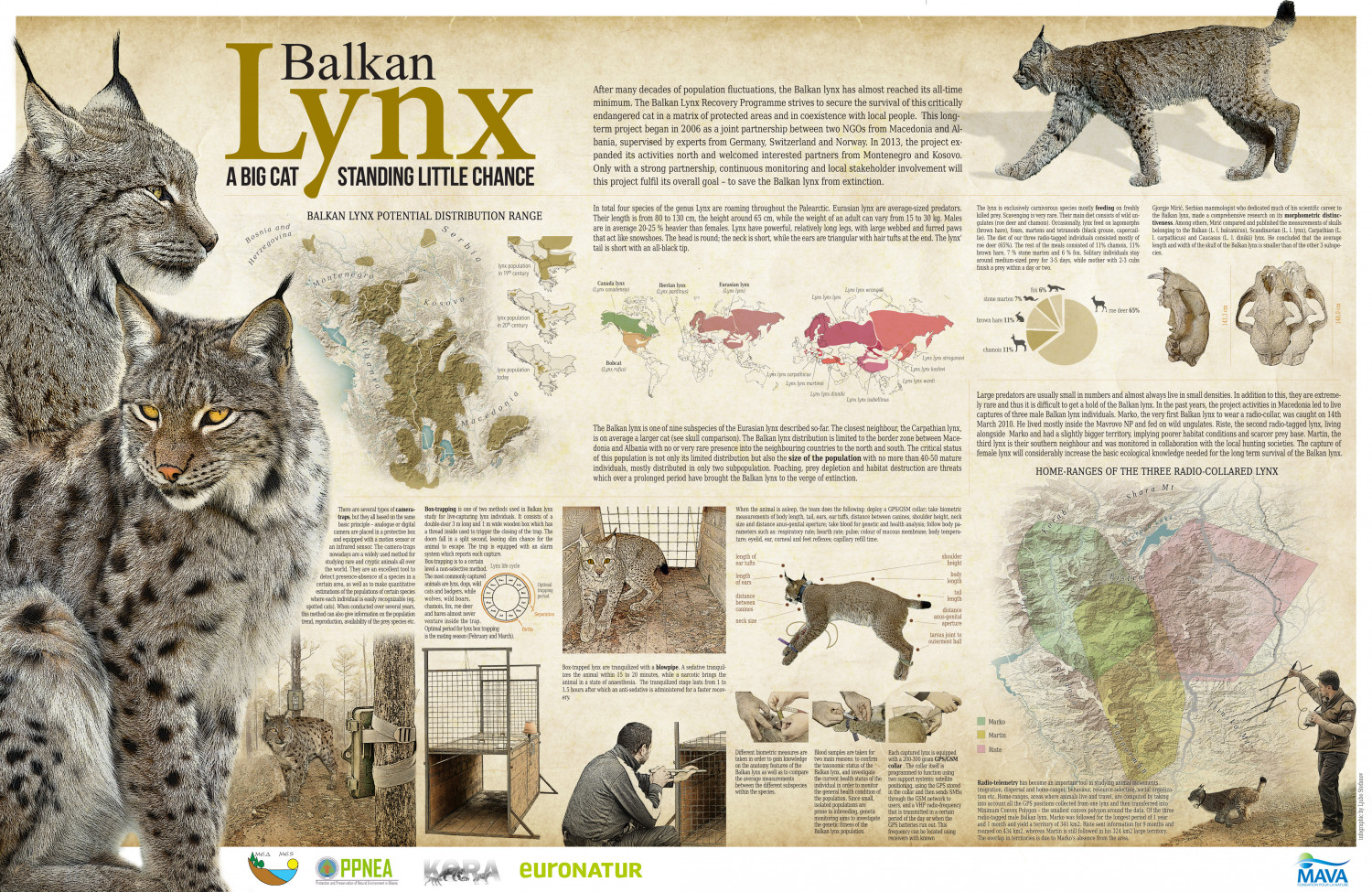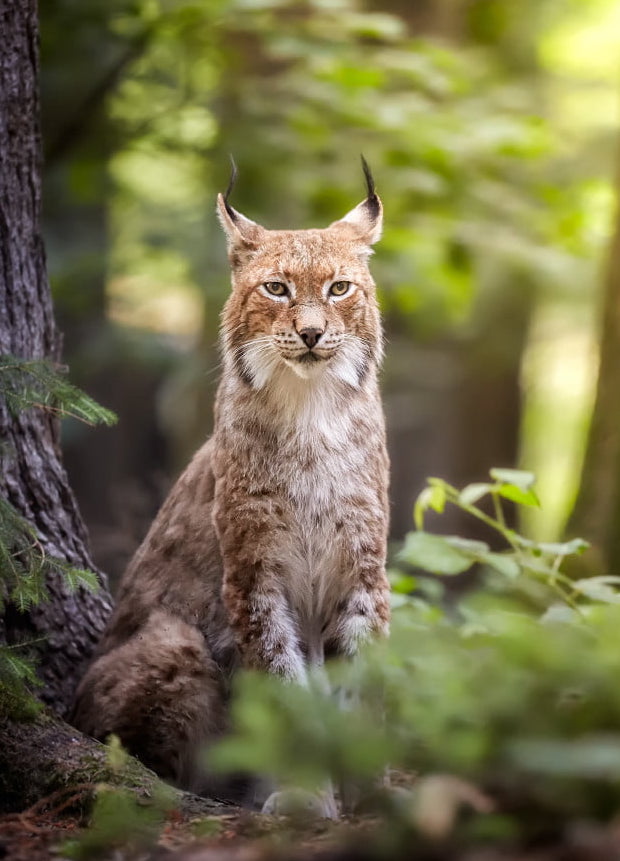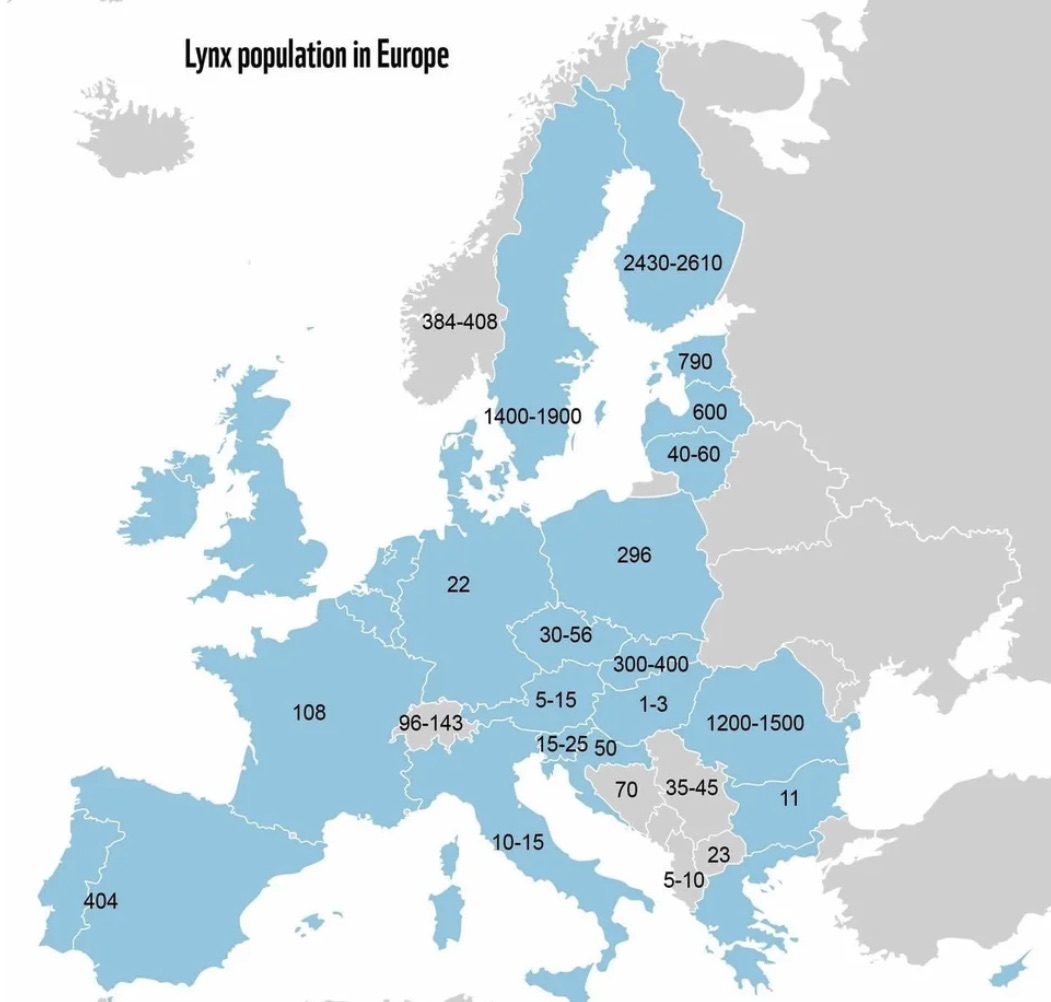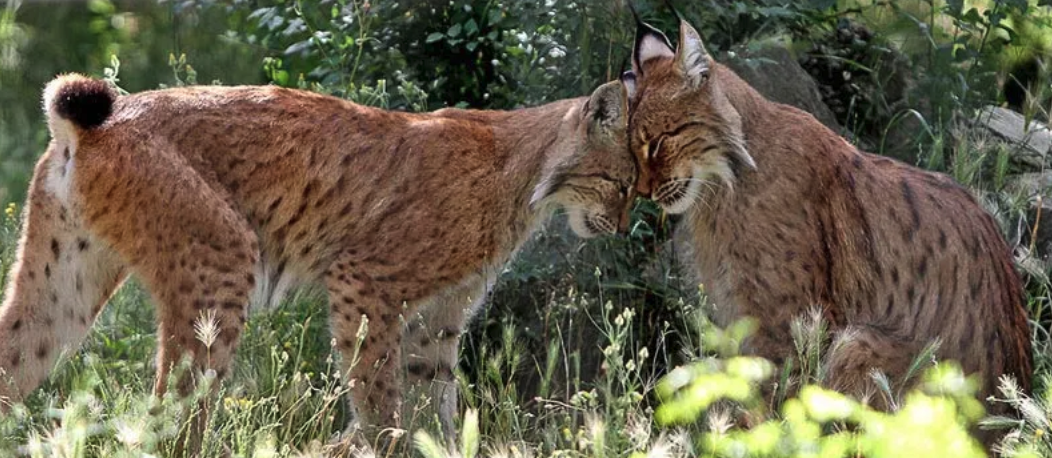Shy guy . . . "One out of three people questioned weren’t even aware of the cat’s presence in their region." [o]
“The hushed limbs of forest,
Of clouds, of mountains, here
Take their hard-earned rest
Under the lynx’s ear.
In his sleep, they sleep –
As in a deep lake – deep.”
– Ted Hughes, 'Lynx' (1981)
EUROPE'S BIG CAT
There’s a hint of a smile on the lynx’s face that lends him an optimistic look, that augurs well for the future of Europe’s only big cat. The last of them. Ever since the last lions disappeared from the old continent a century or more BC.
Not so long ago, in the nineteenth and into the twentieth century, the Eurasian lynx, largest of all four lynx species (Canadian, Iberian, Eurasian, North American bobcat), was either on his way out, or extirpated from, mainly, the western parts of Europe. His last strongholds were in the Scandinavian, Baltic and Carpathian regions. No informed nature lover will be surprised by the following enumeration of usual suspects guilty of the lynx’s waning presence: bounty killing, farmer’s retribution, fur trade, loss of prey, habitat fragmentation.
Now that the Iberian lynx, a separate lynx species (L.l. pardinus), is making a comeback in Europe, the Balkan lynx,(L.l. balcanicus) has the unfortunate distinction of being the rarest among the six recognized subspecies of the Eurasian lynx, (the other five are: Northern: L.l. lynx; Siberian: L.l. wrangeli; Carpathian: L.l. carpathicus; Caucasus: L.l. dinniki; Turkestan: L.l. isabellinus).
Short-tailed, tufted-eared, elegantly spotted, the Eurasian lynx and therefore the Balkan lynx, is, on average, a twenty to thirty kilogram medium-sized cat, comparable to the size of an Irish Terrier. His oval pupils, neither elliptical like a small cat’s nor round like a big cat’s, proclaim his intermediate status. As if to adapt to Europe’s often gentle and decorous countryside, he neither roars nor attacks man. His laryngeal and diaphragmatic muscles give him the ability to purr. Only if challenged in some way will he produce a strident howl that, on a dark night, might leave one suddenly pleading for divine protection. But on the whole, his dapper form and Cheshire cat smile seem ideally suited, both in a practical and cultural sense to Europe’s well-groomed, snug, anthropic landscapes. Centuries of only fleeting observation of this forest dweller have placed him, in our minds, between shadow and light, between natural and supernatural worlds.
He would no doubt be surprised to discover that he has become an international strategist on more than one front.
The lynx was believed to be able to transform his urine into a red gemstone known as Lyngurium. Hildegarde von Bingen, the Benedictine nun, herbalist, composer and proto-environmentalist, wrote of the lynx in her work ‘Physica,’ that it “… follows its own will, its eyes shine like the night’s stars…” She added that his potent blood, when mixed with water and given to sick farm animals (except goats and sheep) would make them healthy again. By many he was believed to see the truth of things in a metaphysical sense, and — though he may have been regarded with respect under a spell of magic and mysticism — he was more prosaically valued for his fur and, to a minor degree, for his pleasant tasting meat. If he attacked farm stock he was hunted as a common nuisance.
These days Europeans face the happy prospect of the on-going plan to re-wild and therefore re-enchant Europe’s nature. In this instance, the lynx is given the chance to re-assume throughout the continent his apex role as ‘trophic cascade’, or, regulator of an ecological system. As Europe’s only ‘big cat’, he may carry much of the romantic impetus contained in this re-vitalization. As a flagship and umbrella species in the South Balkan countries of Montenegro, Kosovo, North Macedonia, Albania, the big cat seems already on his way to assume the heightened position of environmental arbitrator, guardian, but possibly also cultural hero.
Specifically, he embodies a valuable genetic variation, and with a population estimated at fifty individuals in 2015 by the IUCN (International union for the conservation of nature), the survival of the subspecies is not guaranteed to this day, and remains listed as ‘critically endangered’. A first goal has been, therefore, to consolidate the genetic variance by increasing lynx numbers on the basis of the small core populations found in the South Balkan region.
In the wider cultural context of the rewilding Europe plan, introduced in 2011 by the European Union, the Balkan lynx has a key role to play. The Balkan lynx may also, unwittingly, be a means for the South Balkans to achieve a subtle balance between fine-tuning their respective national identities, while simultaneously instigating environmental cross-boundary cooperation between recently independent countries: Albania, (in 1912, though only in 1992 did it become a democratic republic), North Macedonia (in 1991), Kosovo (in 2008), Montenegro (in 2006). It may well prove to be the best way to bring about enduring stability to a notably unstable region. With over-lapping ecosystems between them and several national parks alongside borders, a working transboundary cooperation would seem like an excellent idea. It would preserve the integrity of a particular environment and offer itinerant animals like the lynx, a larger and un-fragmented range. Furthermore, pooling scientific research and wildlife monitoring might prove financially cost-effective and time-saving to the cooperating nations.

The sublime nonchalance only cats seem to possess. [o]
COUNTING BALKAN LYNXES, EN SITU
Such a collaborative configuration is already successful at a scientific and non-governmental level. The BLRP (Balkan Lynx Recovery Plan), financed by the Swiss MAVA Foundation, began in 2006 as a collaboration between, Albania, North Macedonia, Germany, Switzerland and later on, Kosovo. The project aims to bring the fragile Balkan lynx population to sustainable levels without relying on reintroduced lynxes bred in captivity, as was done for the Iberian lynx. ‘Critically endangered’ represents a 50% chance of extinction in the next 10 years, while ‘Endangered’ represents only a 20% chance of extinction in the next 20 years. For biologist Manuela von Arx of the Swiss NGO KORA, in order to boost L. l balcanicus' status from ‘critically endangered’ to ‘endangered’ — and eventually, to ‘vulnerable’ — a total of 250 to 275 adult individuals will have to be reached. For both Alexander Trajce, director of Albania’s PPNEA (Protection and Preservation of the Natural Environment in Albania) and Dime Melovski, head of the lynx project in North Macedonia’s MES (Macedonian Ecological Society), of that total, at least a hundred adult lynxes should be in Albania, another hundred in North Macedonia. To attain a population of a thousand lynxes will take seventy years, by Melovski’s estimation, and only if all conservation measures are strictly followed.
At present, the Balkan lynx’s stronghold and best hope rests in North Macedonia’s 730km2 Mavrovo National Park. Like most of the country, Mavrovo offers a mountainous, well-wooded, well-watered aspect, ravishingly pristine to the eye. As I travel with the MES field biologist, Andrej Gonev, he indicates a rocky outcrop ahead of us, rising high up on the mountain, above the tree canopy.
“The camera trap is up there. Let’s go.”
Andrej’s job is to verify all the cameras at regular intervals, depending on the season. He is rail-thin, very fit, and on this hot summer day exudes an almost spiritual glee at the prospect of a steep, pathless climb to the camera trap. Evidently, the field study of a wide-ranging apex carnivore like the Balkan lynx requires not only inexhaustible optimism but also a Spartan physical condition.
Alas, this time, instead of trapping a lynx, the camera has snapped some happy hikers having fun with the device. It’s all right. the biologist is relieved that the camera was not stolen, as sometimes happens. We move on to two other sectors of the park and more traps. Camera trapping is preferred by this team as the more reliable method of identifying and counting lynxes. Between February and May 2021, sixty cameras were placed in Mavrovo and identified eight or nine adult individuals. Never placed randomly but in agreement with the field scientist’s knowledge of the terrain, and in accordance with the lynx’s habit of keeping to high ground, which is along a ridge or just below and parallel to it. In this manner, the lynx avoids human presence, conserves energy and has a good view of prey below. For optimal identification, cameras are placed in such a way as to capture both flanks of the cat.
Wildlife sometimes has strange allies, and Communist isolationism was that for 49 years, affording the lynx unexpected protection by way of an authoritarian regime. In the 1970s, 280 lynxes were found still living in the South Balkan region. The reopening of Albania had unfortunately the opposite effect, causing a free-for-all, including illegal timber cutting and poaching of lynx and his prey.
The South Balkan countries are predictably eager to develop their economies and modernize their infrastructures, however some of these projects could have catastrophic effects on wildlife. Such appears to be the vast Skavica hydroelectric dam project on the Drin river, recently signed between the Albanian government and Bechtel Corporation. Albanian hydro-biologist at EcoAlbania, Olsi Nika, is adamantly opposed to all dams, referring to them as environmentally ‘dirty’. The Skavica project, which involves the creation of a thirty kilometer artificial lake, will impede the movements of a Balkan lynx between the two key areas of the Munella Mountains and Mavrovo. The project will also, in Olsi Nika’s view, wreak havoc on all natural processes in the area. Yet in a 2020 article in the New York Times, Brad Plumer suggests that there may be a way out from the perennially bad relations between environmentalists and dam builders. With the use of new turbines that no longer block the passage of fish and maintain oxygen levels in the water, hydro-electricity offers a strong argument for carbon-free energy. These more environmentally sustainable dams encourage the dismantling of outdated dams to free up rivers.

The Balkan Lynx has a large network of advocates in the European Green Belt. [o]
If only twenty-five per cent of lynx cubs reach adulthood, and given the small total number of the Balkan lynx population, conservation should indeed be conducted with air-tight rigor to insure their survival. Albania, alone among the four South Balkan countries, has taken drastic measures, making all hunting illegal from 2014 to today, with hopefully an extension of the ruling. Sanctions against intentionally killing a lynx have hardened since 2019, from a modest fine to seven years imprisonment.
REWILDING A CONTINENT AS SOCIAL CHANGE
In our digital age, tiptoeing into that of robotics, genomics and material science, it may be that the European Union is putting its best foot forward with the plan to re-wild Europe. This re-booting of Europe’s nature comes at a time when an incipient sense of dehumanization and consequent isolation, seems consubstantial with an ubiquitous and increasingly sophisticated technology. Yet, despite the immediate advantages of such devices, they do not seem, in the long run, to benefit either the private citizen or society at large. A wish to reconnect with nature, a sense of the genuineness, privacy and freedom it offers — perceived as no longer possible elsewhere — infers a more equitable sharing of land with wildlife, including with large mammals. It is possible that this planned re-invigoration of nature has also the ulterior motive of smoothing out socio-political glitches and solidifying the European Union’s jurisdiction.
In this case, the Balkan lynx is far more than just an asset of South Balkan biodiversity and appears as a re-unifier and even a proponent of membership in the European Union.
The twenty to thirty kilometer wide Balkan Green Belt in the southernmost portion of the European Green Belt hugs three sides of Albania and North Macedonia, the west of Kosovo, the south of Montenegro, and its eastward flourish to the Black Sea, goes north of Greece and south of Bulgaria. It presents itself as a first major artery for Europe’s now expanding green network to reach out to and connect with. The first five main areas of this network are Western Iberia’s Montado pastures, Croatia’s Velebit Mountains, the East Carpathians, the South Carpathians, the South Danube Delta; in the process of being extended by four more areas: Central Apennines, Greater Laponia, Odra Delta (Poland-Germany), Rhodopes(Bulgaria-Greece). Corridor links between these areas will provide continuous north-south and east-west axes for wildlife circulation.
How can such a plan be executed in densely settled Europe? The solution lies in new techniques that improve agricultural yields on smaller land parcels and the socio-economic reality of farmland abandonment.
Between 2015-2030, it is estimated that 11% of farmland in Europe will be abandoned (EU Science Hub). The hope, or prospect of a cutback in cattle land (occupying now some. 77% of the farmland) would enhance this process. Accelerating it further, could be the commercialization of cell-grown meat in place of butchered meat (though opinions diverge on how soon it could be marketed, and how well consumers would accept such a change).
As they stand with one foot on the EU’s threshold, the South Balkan nations represent a fund of biodiversity that is valuable to Europe’s rewilding plan.
According to Bledi Hoxha of PPNEA, the Balkan lynx can still move fairly freely throughout Albania. But a successfully expanding lynx population will require that connectivity be secured beyond the country’s borders. 6.6% of Albania, 12.46% of Montenegro, 11.5% of Kosovo, 12% of North Macedonia, are protected land. Within and without the South Balkan countries, some twenty patches, equivalent to a total of 42,420 km2, have been pin-pointed as suitable for further conservation.This additional land would improve the Balkan lynx’s chances to mingle with his Dinaric and Carpathian brethren in conjunction with connecting corridors. At this stage, to ensure without delay a safe passage between the Munella Mountains and Mavrovo is the priority which will give the Balkan lynx a better chance to thrive.

"Due to the lynx’s shy and solitary ways, people were likely to lend him less individuality and feel less empathy towards him, compared to the more easily anthropomorphized bear." [o]
THE BALKAN LYNX AS A NATIONAL ASSET
The return of a Balkan lynx population to sustainable numbers will not just perform its basic function to keep an ecosystem healthy. For humans, it will help replenish certain psychological and cultural dimensions. Social anthropologist Alexander Trajce and eco-ethnologist Nicolas Lescureux have focused on human perceptions of the lynx in the south Balkans. It was found that one out of three people questioned weren’t even aware of the cat’s presence in their region. Others, appearing to hark back to old beliefs, perceived him as larger than his actual size and therefore dangerous, sometimes in unrealistic ways (Nicolas Lescureux’s research found that 54.4% of the people questioned, considered the lynx harmful). A 2006 survey showed however, that wolves attacked farm animals far more than bear or lynx did. Yet because of the lynx’s shy and solitary ways, people were likely to lend him less individuality and feel less empathy towards him, compared to the more easily anthropomorphized bear. However, from a farmer’s point of view, the lynx was better than the destructive wolf, and the feline was though mistakenly credited with keeping the wolf away.
Lynx conservationists have, therefore, made it an essential part of their work to inform the public and diffuse negative perceptions of the lynx in their respective countries, while also hoping to ignite national pride in the animal. A big stride in that direction was made when, in 1993, North Macedonia chose to put a Balkan lynx, designed by national artist, Biljana Unkovska, on its five Denar coin, one of four coins devoted to national biodiversity. Albania has, for its part, devoted several postal stamps to the lynx.
During a leisurely discussion at Dime Melovski’s house, overlooking an admirable North Macedonian panorama of steep wooded slopes and narrow vales, it became obvious to the writer that, for the host and his team, the future of the Balkan lynx was inextricably woven into the nation’s identity and future.
A previous chance encounter in Skopje with the young owner of the small but hip café ‘Da Be Da’ suggested that the general public might share such a vision. Every first Monday of the month the cafe ‘Da Be Da’ typically has held an exhibit on a local artist. However, the owner seemed eager to deviate from the usual art theme in the future, and to put the Balkan lynx in the limelight and show him as a national asset. The owner of the café was furthermore eager to broaden his focus to other environmental subjects.
CROSS-BOUNDARY COOPERATION
Cross-border conservation that preserves the integrity of an overlapping ecosystem is not a new concept. The 3000km2 Balkan Peace Park is one of six hundred such TBPAs (transboundary peace areas) around the world; forty-one shared environments are in place in Europe. They are a practical stratagem to solve a lack of natural space in one country and counteract land fragmentation. With a similar idea in mind, the Vermont-based Institute for Environmental Diplomacy and Security (IEDS) presents environmental diplomacy as having the capacity to build harmonious cohabitation on the planet. In this perspective, wildlife like water, wind, sun, becomes part of a strategy towards establishing better international relations. The value of wildlife evidently extends beyond environmental concerns to the larger scale of forging political alliances.

"Wildlife ecotourism would certainly propel the lynx from scientific concern, to object of national and regional pride." [o]
B3P, or Balkan Peace Park Project, came to life as a charity in 2004, bringing together Kosovo, Montenegro and Albania. At the heart of the project, nature preservation intends to facilitate conciliation and deepen it with cooperation. At a practical level, it aims to revitalize rural economies within their specific cultural frameworks. Ecotourism, in its various forms, emerges as an off-spring of the project. In this context also, the Balkan lynx is bound to be an important factor towards cementing transnational cooperation. Treading furtively through his native mixed forests of oak, beech and pine, this rare subspecies would, no doubt, be surprised to discover that he has become an international strategist, and on more than one front.
But the charisma of the Balkan lynx is already such in Montenegro. Though proof has yet to be found of a breeding population there, he is nonetheless the focal point of a ten day lynx-sighting eco-trip proposed to small groups of less than ten travelers in the Prokletije National Park area near the Kosovo border.
In fact, rural communities in the South Balkans offer an ideal foundation for the elaboration of different types of ecotourism. For Albania and Montenegro, ecotourism offers an outlet to avoid one dimensional, coastal tourism which invariably leads to mass tourism. The Albanian region of Ana e Malit, deserted by many of its inhabitants in the 1970s for economic reasons, typically possesses an array of historical, natural and wildlife resources to draw upon for a diverse ecotourism. The example is not rare in this part of the world and all four countries have their fair share of natural beauty and historical sites. As a region, the South Balkans represent Europe’s new tourism frontier. Therefore, a well preserved nature protected by a system of environmental cooperation between the four countries, more or less at the same stage of environmental conservation, seems like an ideal setup. It would both fortify a certain commonality while encouraging to build on national specifics. Wildlife ecotourism would certainly propel the lynx from scientific concern, to object of national and regional pride. Friendly emulation between the countries could further encourage improvements in both conservation and tourism. If ecotourism develops and contributes significantly to a national economy, it may end up being the best argument to convince reticent or indifferent governments of the benefits of transboundary cooperation.

Dime Melovski notes that his attempts to interest the higher echelons of North Macedonia’s government in taking a more active part in transboundary cooperation failed. He has since redirected his efforts to the lower echelons of the administration, hoping for a better result. Alexander Trajce and Olsi Nika bemoan a similar situation in Albania. Environmental initiatives across borders have until now solely been taken by NGOs and scientists. The lack of governmental engagement reflects, in Dime’s view, environmental and administrative immaturity which, in turn, presents an obstacle to long-term planning. In his opinion, the main culprits are an absence of bureaucratic ‘know-how’ on implementing cooperation, and an incapacity to look beyond political interests.
Within the European Union, however, the lynx is in the process of becoming entrenched in his rightful environment through the work of organisms or programs like Eurolynx Network (2018), LCIE (Large Carnivore Initiative for Europe,1996), SCALP (Status and Conservation of the Alpine Lynx Population, 1995). These provide the lynx with a safety net of regular monitoring, data logging and sharing. Less noticeably, but perhaps more essentially, such initiatives effect a rooting in the European public conscience. Expanding lynx populations then becomes part of Europe’s connective tissue, ecologically and culturally.
OPPORTUNITIES AVAILABLE TO EMPATHIC SYSTEMS
The prospect of Europe's re-wilding suggests a throw-back to antiquity and finding new solace in a kind of neo-pantheism. The collaboration between European countries implied by the re-introduction of the lynx — and, specifically, the Balkan lynx — could promote the cat to being a social totem rather than just a gauge of environmental health. This would reflect a more visceral regard for nature than previously experienced.
Let’s imagine, for a moment, this new relation to nature in Europe and how it could produce, in its wake, on a societal level, a philosophical trend — a metamorphosis of our rational materialism into a kind of Orphic mysticism. From Karen Davis, in Wild animals and human life: savage din, soft lyre and the call of wild natures, comes the notion of Orpheus’ lyre, symbolizing a greater empathy with nature that would draw animals back to us in a more forgiving and coequal proximity.
We might then, at last, be able to break away from the on-going contradiction experienced with nature. That is, to do away with the paradox in which we long to experience wilderness and its denizens, even while nature — marked by the absenteeism or extinction of its inherent inhabitants — goes on shrinking . . . through our human doing.
May we soon hear Orpheus’ lyre. ≈ç

STEPHANIE V. SEARS is a Franco-American ethnologist, journalist and essayist whose articles and essays on environment and wildlife have appeared in E, The Environmental Magazine, Cerisepress, The Montreal Review, Insula (UNESCO), Zoomorphic, Ecohustler, and wildlifeextra.com. She divides her time between Paris and Massachusetts.


Comments
This is really encouraging…
This is really encouraging to hear. Congratulations, everyone. There is a lynx on our peninsula that faces Oslo..
Add new comment